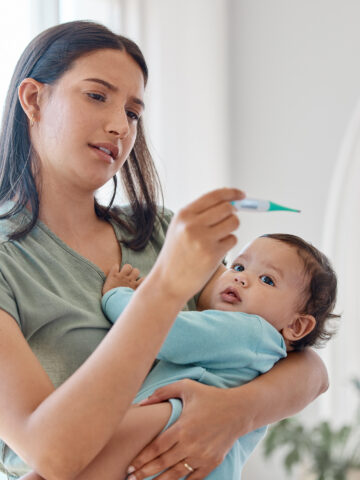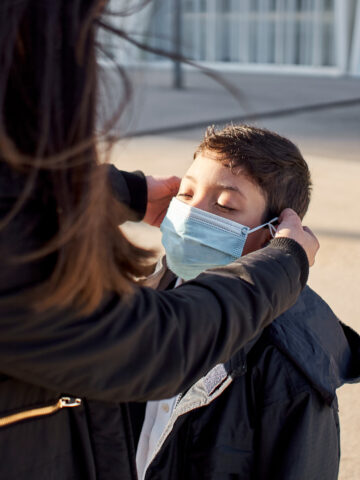Social distancing and proper hand-washing are critical ways to protect yourself and your family from COVID-19. Cloth face coverings are an additional step to slow the spread of COVID-19. Get answers to your frequently asked questions in this Q&A with CHOC infectious disease experts.
The Centers for Disease Control and Prevention recommends cloth face coverings in public settings in places like grocery stores and pharmacies where physical distancing measures can be difficult to maintain. These face coverings can slow the spread of COVID-19 and help people who may have the virus and do not know it from transmitting it to others. It is not necessary for children under the age of 2 to wear cloth face coverings.
The governor of California has mandated that face coverings be worn by the general public when outside the home. This applies to high-risk situations such as entering public spaces; obtaining medical attention; riding public transit; certain work settings; and while outdoors in public spaces when maintaining a physical distance of 6 feet from persons who are not members of your household is not feasible. Exemptions include children age 2 and younger; persons with a medical condition, mental health condition or disability that prevents them from wearing a face covering; the hearing impaired or those communicating with them; persons seated at restaurants while eating or drinking, provided they maintain physical distancing; and those engaged in outdoor work or recreation alone or with household members while maintaining physical distancing from others. Read updated guidance here.
Children under age 2, or anyone who has trouble breathing, is unconscious, incapacitated or unable to remove the mask without assistance should not use a cloth face covering.
Wash your hands before putting on your face covering. It should cover your nose and mouth, be secure under your chin, and fit snugly against the sides of your face. Make sure you can breathe easily while wearing your mask.
The CDC recommends the following for increased protection:
Knotting the ear loops or twisting the ear loops of a mask and then tucking in and flattening the extra material close to the face. It’s important that the mask is secure over the nose, mouth and sides of your face. There should be no gaps.
Don’t put the covering around your neck or up on your forehead. Avoid touching your face covering. If you do, wash your hands.
N-95 or surgical masks are not recommended for public use, as supplies are needed by healthcare workers and first responders.
The CDC offers tutorials for sewn and non-sewn face coverings.
Untie the stings behind your head or stretch the ear loops. Only hold your face covering by these ties or strings to avoid transferring any germs that may be on your hands onto the portion of the cloth that covers your nose and mouth.
Wash your hands after removing your face mask.
Wash your face covering frequently, using one of these methods:
In the laundry – It’s OK to include your face covering in your regular laundry. Use your regular laundry detergent and the warmest possible setting for the cloth used in your face covering,
By hand – When washing face coverings by hand, the CDC suggests using a bleach solution by mixing 5 tablespoons (or 1/3 cup) of household bleach per gallon of room temperature water OR 4 teaspoons of household bleach per quart of room temperature water.
Soak the face covering in the bleach solution for five minutes. Then thoroughly rinse with cool or room temperature water. Always check the label on your bleach before using. Ensure your bleach is intended for disinfection, and that it’s not past its expiration date.
Never mix household bleach with ammonia or any other cleanser.
Many people with COVID-19 have no symptoms. Wearing a face covering helps protect others in your community – like those with autoimmune disorders or the elderly – in case you’re infected but don’t have any symptoms.
Some children may incorporate mask wearing into their daily lives with ease, while others may find it odd, uncomfortable or even scary. If your child is having trouble wearing a mask, here’s advice from a CHOC pediatric psychologist on how to ease their fears.
Additional resources
The Orange County Health Care Agency has a printable graphic that offers an overview of how to wear and wash your mask available in multiple languages:
This article was updated on Feb. 12, 2021.
Get more expert health advice delivered to your inbox monthly by subscribing to the KidsHealth newsletter here.
Learn more about COVID Vaccines for Children and Teens
Get answers to your frequently asked questions – and some peace of mind – with this complete guide to COVID-19 vaccines from CHOC pediatric experts.





